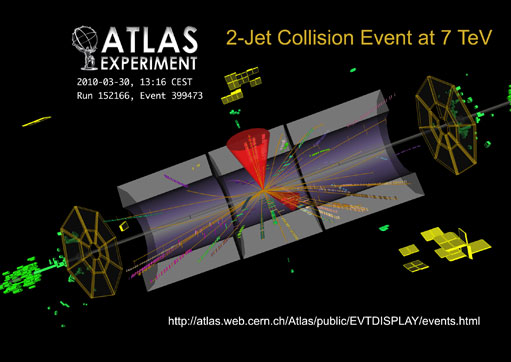
ATLAS e-News
23 February 2011
Hadronic Calibration Workshop
4 October 2010

An early 7 TeV collision event with jets, taken at 13:16 on 30 March 2010
The sight of 100 physicists all trying to get “that photo” of themselves holding up/pushing over the famous leaning tower may have been standard fare, but what came as a surprise to many at last month's Hadronic Calibration Workshop in Pisa was the astonishing level of agreement between early ATLAS data and Monte Carlo simulations. Not only that, ongoing 'in-situ' studies with real data will drastically reduce the level of uncertainty in ATLAS measurements, which is set to have a big impact on the accuracy of new physics over the coming months.
“It's important that we're convinced our Monte Carlo simulation and our data match, because we're deriving our calibrations from the Monte Carlo,” explains Columbia grad student Kerstin Perez. By comparing reconstructed data with Monte Carlo 'truth', effects on how jets shower and progress through the detector “an incredibly complicated process that no-one can really describe fully” can be corrected for.
The fact that Monte Carlo simulation and data are lining up so nicely means that: “
we understand a lot of things incredibly well, which is why it feels so surprising,” Kerstin smiles. “We understand basically how the underlying physics is working, even at this brand new centre-of-mass energy. We understand how our detector is modelled, and we can see it working the way we expect it to work.”
'In-situ studies' refers to those based on real data. Where these have been performed on the decent chunk of data now at hand, they've shown that simulated and real data agree to within about five to ten per cent of one another, in most cases.
One such study compared the ratio of isolated particle track momenta and their associated clusters of energy deposited in the calorimeter, in both data and in the simulation. “You find that agrees within five per cent over most of the range,” Kerstin reports.
Jet energy scale calibrations basically how to correctly infer the energy of a jet from calorimeter measurements also received a lot of attention at the four-day workshop. Until now, physic results have used jets calibrated with pre-defined calibration factors, derived from Monte Carlo simulation; factors which vary according to the momentum of the jets and the specific region of the detector where the energy was measured.
Now, more sophisticated data-driven studies are improving the confidence in the calibrations, and allowing a reduction in the 'jet energy scale uncertainty'. “This is the one thing that most people care about when they talk about a jet calibration,” explains Kerstin, who is involved in gamma-jet studies.
“If you take events where you have a photon and a jet totally back-to-back, their transverse momenta should balance,” she explains. “The photon is really well measured by the calorimeter, so the photon we pretty much trust. The jet though that's much more complicated.”
The accuracy of the calorimeter photon measurement means that the transverse momentum of the photon can be calculated with confidence and used to infer the transverse momentum of the jet. Comparing this to data validates the Monte Carlo-based calibration and can reduce the uncertainty in calibrating jet energies.
“The total jet energy scale uncertainty was around six to nine per cent before, a conservative estimate,” says Kerstin, “but using these in-situ studies, we can start to squeeze the numbers down
What's really exciting is that we think that in the next few months we can greatly reduce that uncertainty.”
This should put ATLAS in a good position ahead of the winter conferences and papers. Eventually, calibration factors from Monte Carlo simulation could be phased out, and instead be derived entirely from in-situ data-based measurements like these. “But that's on more of a 'next summer' timescale,” Kerstin smiles.
At that point, confidence in the photon-derived calibrations should be such that multi-jet calibration of very high energy jets basically inferring the energy of one large jet by looking at a collection of lower energy jets recoiling against it will be possible. This method will allow the calibration to be checked for jets with energies up to 1 TeV a region that has never before been measured. Other in-situ studies, also hinging on the transverse momenta-balancing principle, are investigating how well different regions of the detector are understood.
Aside from jets, calculating uncertainties in missing Eτ was also under discussion. “In many cases, missing Eτ is greatly affected by jets, and also the stuff that falls outside of the jet. They sort of interplay with each other,” Kerstin explains. “To validate their uncertainties, the missing Eτ group need more data for their in-situ studies, so it becomes a question of exactly where to start coming up with an uncertainty. There was a long discussion on how to make sure that we do something compatible in missing Eτ and in jets.”
Now that the LHC is using full bunches of protons, multiple soft interactions can occur concurrent with the main collision event. These can alter both the energy and reconstructed shape of jets, so something to deal with the pile-up is essential. But, says Kerstin, “if you assume pile-up is depositing extra little bits of energy all over the place,” and apply a new general offset correction factor, remarkably, the effects of pile-up on jet shapes, on average, all but disappear.
 Ceri PerkinsATLAS e-News
|